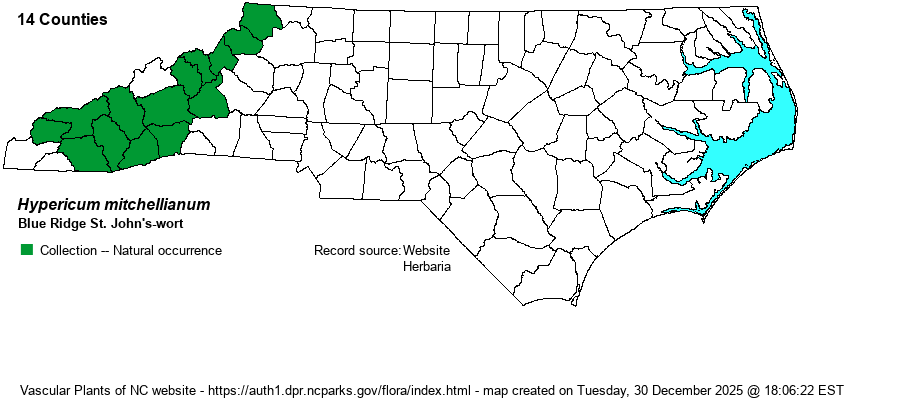| Section 6 » Order Theales » Family Hypericaceae |
Show/Hide Synonym
| taxonName | relationship | relatedTaxonName | relatedTaxonRefText | relComments |
|---|
|
|
|
|
|
|
|
|
|
|
|
|
|
| Hypericum mitchellianum | = | Hypericum ×mitchellianum | Flora of North America (1993b, 1997, 2000, 2002a, 2002b, 2003a, 2004b, 2005, 2006a, 2006b, 2006c, 2007a, 2009, 2010) | | | Hypericum mitchellianum | = | Hypericum ×mitchellianum | Stevens in Kubitzki, Bayer, & Stevens (2007). Key based in part on Adams (1973), Godfrey (1988), C, and GW. {add for FL: Hyperi | | | Source: Weakley's Flora |
|
| Author | Rydberg | |
| Distribution | This species is restricted to the Mountains, and within that province is found mostly at high elevations (mostly above 4000 feet).
This is a Southern Appalachian endemic species, though this is the more northerly of the species pair of high elevation erect species – H. mitchellianum and H. graveolens. It ranges from WV and VA south only to southwestern NC and neighboring TN; it has yet to be found in SC or GA.
| |
| Abundance | Generally uncommon to infrequent. Found over a wider geographic range, and at presumably more sites, than is H. graveolens, though the latter can be quite common locally. This is a Watch List species. | |
| Habitat | This species occurs more often in wet spots and seepages than is the very similar H. graveolens. It is most often found in seepages, but can be found in spray zones of waterfalls. It also is found in drier areas around grassy balds and outcrop margins, as well as in open forests, generally in full to partial sun. | |
| Phenology | Blooms and fruits in July and August. | |
| Identification | This is an herbaceous species that grows to about 1 foot tall on average, with branches mainly in the upper part of the stem. The opposite leaves are somewhat elliptic and have black spotting, and reach about 1.5-2 inches long and about half as wide. It can be identified from the very similar H. graveolens, which may grow in the same habitats, by several features: 1) it has black lines and black spots over the surface of the petals, and not just black spots along the margins as with H. graveolens; and 2) it has more flowers in the clusters, typically 10 or more. Thus, when in bloom or fruit, H. mitchellianum has many more flowers or fruit overall – typically several dozen as opposed to a dozen or less in H. graveolens. | |
| Taxonomic Comments | Because this species has some intermediate characters between H. graveolens and H. punctatum, of lower elevations, several references, including the well-respected Flora of North America, suggest that this species is a hybrid of the two, and give it the scientific name of Hypericum x mitchellianum. However, all other references consider this a good species.
| |
| Other Common Name(s) | None | |
| State Rank | S2S3 | |
| Global Rank | G3 | |
| State Status | W1 | |
| US Status | | |
| USACE-agcp | | |
| USACE-emp | FACU link |

